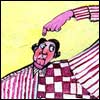Question:
What is the theme of the Tanya? I was just introduced to the book by a Chabad neighbor, and I’m considering exploring this new area.
Answer:
Mazel tov on your discovery of Tanya.
Tanya is the foundational work of the Chabad movement. It lays down the practical and mystical fundamentals of the Chabad philosophy. It was authored by Rabbi Schneur Zalman of Liadi (1745–1812), the founder of the Chabad-Lubavitch movement.
The major theme of Tanya is the ubiquitous Identity Crisis.
There are days when one indeed feels inspired by Judaism and spirituality, and there are days when they are a real bore. There are times when nothing seems more important than studying Torah or praying, and there are times when nothing seems greater than a steak and a good ballgame. There are moments when one is disgusted by the world’s immorality, and there are moments when one is tempted by it.
So, who are we? Are we to ignore our beastly temptations, or come to terms with them? And how is it that people possessing a G‑dly soul can be filled with such animalistic desires?
It is Tanya that guides us through our dual personality. It gives us the insight to understand and overcome the struggles we deal with on a day-to-day basis.
Yes, we have a Code of Jewish Law that clearly tells us how to live every aspect of our life. But, even assuming we can keep the laws perfectly, there’s more. We would still be missing a key ingredient in our service of our Creator.
My behavior may be perfect. I may do exactly as I am told. But it’s not really me. It feels superimposed. There’s still me, and there’s my Torah.
Tanya teaches how to bridge that gap—to create a unity between my Judaism and my inner psyche. It makes my Torah and mitzvot a true representation of my personality. It allows me to truly feel—not merely act—like a Jew.
But allow me to make the following important points:
Tanya is not an easy reader. It takes concentration and dedication.
Tanya is not instant inspiration. It contains no short stories or pearls on the weekly Parshah.
Tanya is not a quick fix. It’s a journey that takes time and energy.
Tanya is a long-short road. It may be lengthy—but when you arrive, you’re truly home.
Tanya is a pair of glasses. When used correctly, everything will look different.
Tanya is a heart. It will pump life and energy into your Torah and mitzvot.
One more point. Studying Tanya properly requires a teacher who is versed in the subject. If you read it in its original Hebrew, or an English translation, you will only be scratching the surface. First of all, Tanya is replete with mystical terms which the uninitiated in this area will not understand. A skilled Tanya teacher will explain these terms and, more importantly, make them practical and relevant. Second, layers of meaning are hidden behind each word.
Speak to your local Chabad rabbi to arrange Tanya classes. If this is not possible, I would recommend you purchase Adin Steinsaltz’ wonderful books on Tanya, Opening the Tanya and Learning from the Tanya. You can also study Tanya online, using Lessons in Tanya, which does offer some help for the layman wishing to navigate Tanya’s deep waters.
Yours truly,
Rabbi Yisroel Cotlar








Join the Discussion